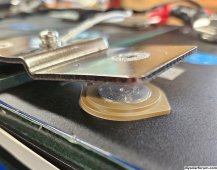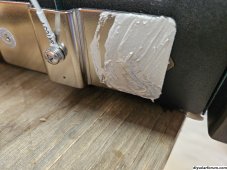I did not get a chance to run much through it today - 40A at most into the battery. I measured temps on the bars in the unit during this period, and didn't really have enough of a variance in temperature to not account for error. A factory welded connection was within 0.1°F of the epoxied contact point. The battery post does have direct contact to the bar, with the epoxy more in place to fill voids and hold everything in place. I plan to test this setup for the next several weeks and then may still put a post into the terminal.
I made a 1mm thick by 1cm wide "trace" of the leftover material last night and tested this with my meter now that it is dry and set. Resistance was 0.1 ohm across a 1cm section for those who may be interested.
I had contacted Atom Adhesives prior to this, and they have been very helpful. For the 902 product they said it should work, but cautioned that I test it. If I needed better conductivity they offered to make a gold mixture epoxy for me, which was pretty interesting but probably more than I want to pay for this test.
I used to use a copper epoxy mix back in the 90s,
@AlpineJoe , when I used to fix arcade games. Mountain Dew and Cherry Coke would eat copper traces off of boards when people spilled their drinks and the liquid leaked onto a board. I've not really messed with conductive epoxies since then though.
If nothing else, this is a fun and relatively inexpensive exercise. The battery I'm testing this on was a recent purchase which was damaged in shipping (FedEx guy tossed/tumbled my batteries out of the van onto the driveway, not realizing I was home). The company sent me a replacement battery and is not too interested in me sending the damaged one back so it's no real loss for me.





